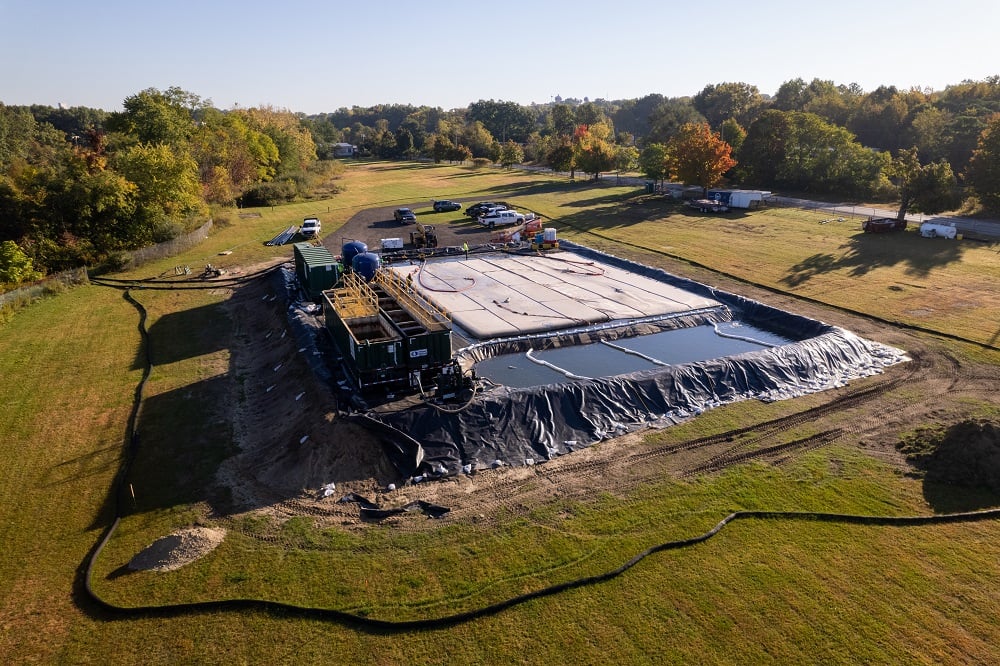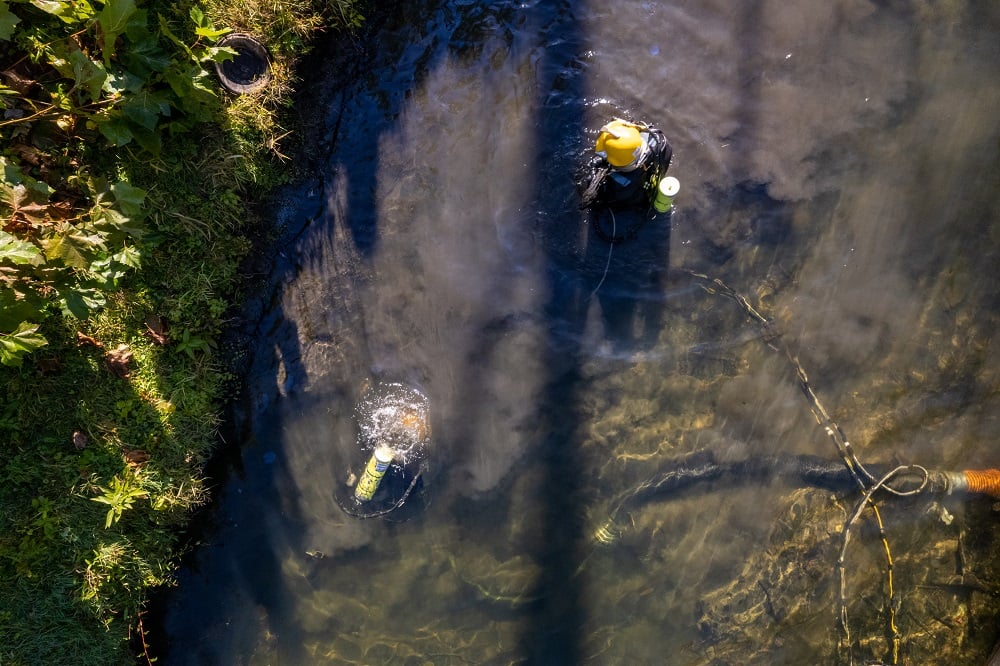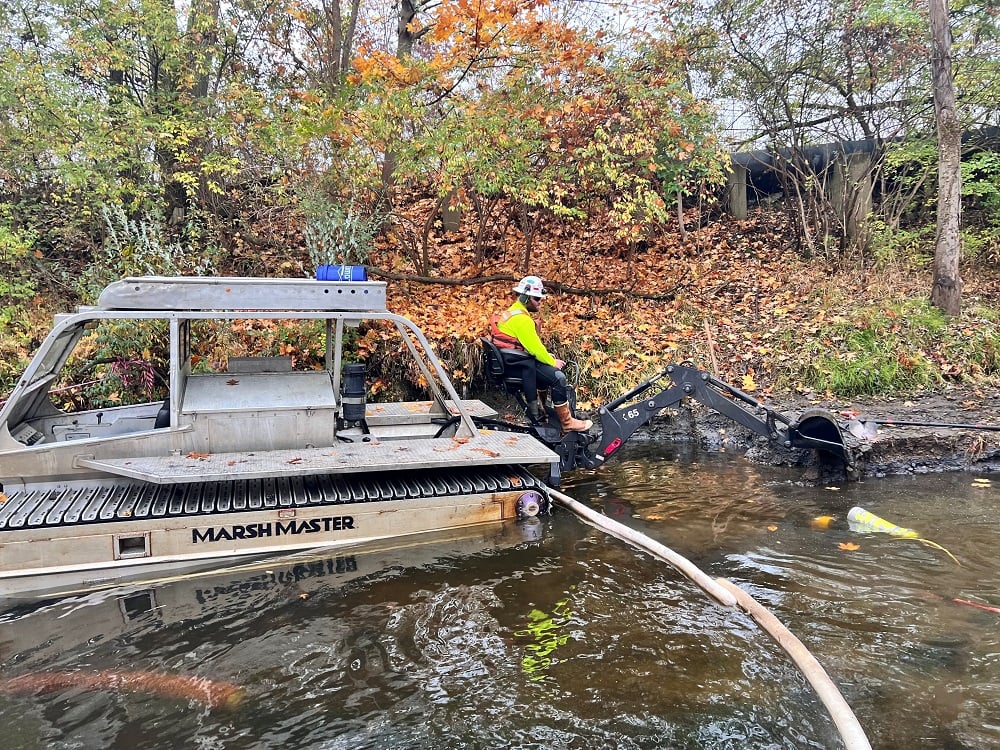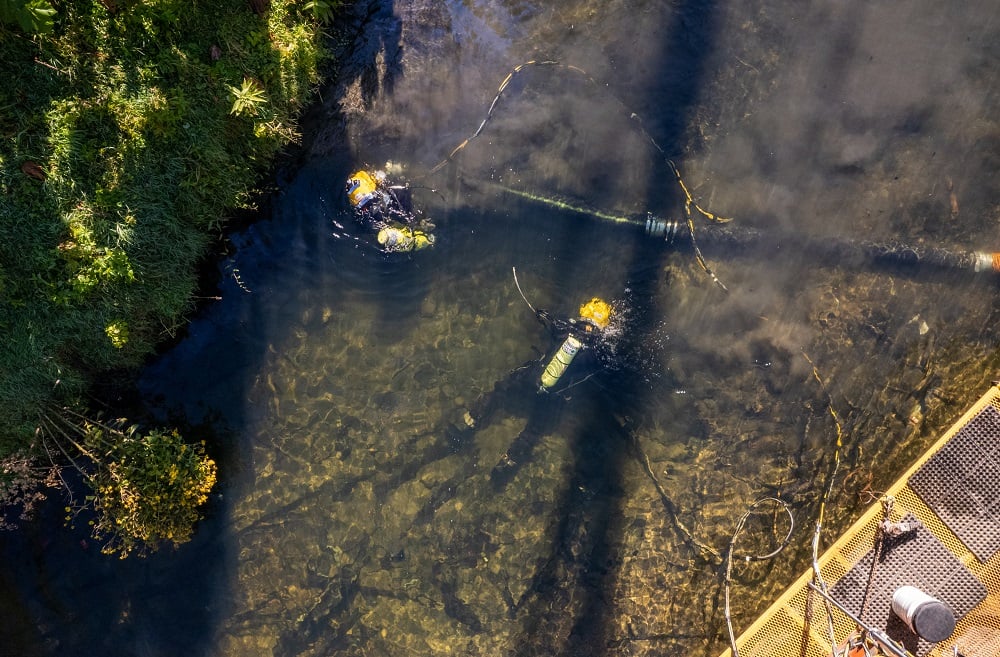The Cuyahoga Improvement Project in Kent, OH, aims to improve future recreation experiences while protecting existing natural resources. The purpose of our work is to remove areas of petroleum-impacted soft sediments that were deposited decades ago from discontinued industrial practices upstream.
Background on a Burning River
The Cuyahoga River has quite a history: a transportation route; a boundary; an origin for oil, rubber, and steel industries; a power source; and a dumping ground. The river was once 1 of the most polluted in the country. The Cuyahoga has caught fire at least 13 times since the 1860s.
The river became infamous around 1969 when it burned for what the community determined would be its last time. This incident helped spark the national environmental movement in the United States.
Proposing Diver-Assisted Dredging
This particular section of the Cuyahoga River featured limiting conditions such as difficult river access, low bridges, and a railroad right-of-way. This is when we decided to promote the idea of diver-assisted micro-dredging to help complete the objectives set by the stakeholder.
What is diver-assisted dredging?
Diver-assisted dredging is a precise method of removing sediment from underwater areas. It involves the use of specialty diving equipment and a 6-IN pump system, along with the efforts and expertise of commercial divers to remove sediments in conditions that require the utmost care. Diver-assisted dredging is especially valuable in areas with limited access, heavily degraded infrastructure, buried utility lines, historical artifacts, or mechanical structures.
Brennan Prepares the Cuyahoga Improvement Project Site
Brennan is the prime contractor for this project, working closely with the client, the City of Kent, and consultant WSP to comply with requirements set by the Ohio Environmental Protection Agency.
We use state-of-the-art diving equipment and can mobilize anywhere in the continental United States in a timely manner while maintaining competitive rates. Preliminary dive inspections and surveys can also be conducted to determine the condition of water-based structures, ensuring that the work is tailored to the specific needs of each project.
To avoid much of the recreational river traffic, tubing, and kayaking of the summer months, our underwater team assembled in Ohio shortly after Labor Day 2022. We utilized a high-visibility floating boom to separate our work area from river traffic.
A crew of 5 Brennan divers, along with help from local company Helmling Excavating, worked together to prepare the site. We imported clean fill to raise the grade and construct the dewatering pad.
 The raised dewatering pad we used to dewater impacted sediment from the Cuyahoga River.
The raised dewatering pad we used to dewater impacted sediment from the Cuyahoga River.
Performing Diver-Assisted Dredging
After completing the dewatering pad, our team started to remove sheen-generating soft sediment from the river via diver-assisted dredging. As divers dredged the impacted sediment, it was pumped to geotextile tubes for dewatering on the dewatering pad. The water that drained from the tubes flowed to a sump, then pumped through an oil water separator, sand filters, and carbon filters. The resulting water was tested to ensure it met all the required discharge parameters and was then pumped via pipeline back to the river.
After the sediment was fully dewatered, the geotextile tubes were opened on the dewatering pad. The material was transported to an approved landfill.
Why is Brennan selected for diver-assisted dredging projects?
We are selected to perform diver-assisted dredging because of our long history as a specialty marine construction and environmental remediation company, and we employ commercial divers who are HAZWOPER certified, ensuring that work is carried out safely and professionally. Plus, all Brennan divers are members of the Association of Dive Contractors International (ADCI), which further ensures that our divers are highly trained and qualified for the job.
Innovation: Diver-Assisted Capping
To restore the river, divers capped areas with virgin sand mixed with Organoclay®. To do this, we mixed clean sand and Organoclay and placed it into a slurry tank from which we pumped it 1,500 FT back to the original site. At the pipe discharge, Brennan developed a diffuser to reduce water flow so our diver could evenly place the capping material. This was a new process for us! Our team demobilized at Thanksgiving 2022.
 This was the first time our divers dredged and capped the same waterway using a custom-fabricated diffuser.
This was the first time our divers dredged and capped the same waterway using a custom-fabricated diffuser.
Challenges We Encountered During the Cuyhahoga Improvement Project
1. Accessing the site was very difficult. There were no boat launches nearby and the river depth ranged anywhere from 6 IN to 10 FT. Due to the lack of access, standard dredge methods were not viable, especially considering our need to minimize the potential impact on the local environment and adjacent federally protected wetlands.
2. We were unable to use a standard outboard motor and instead ordered a surface-drive mud motor from Gator-Tail® which allowed us to maneuver. Since the water level could fluctuate considerably due to releases from the upstream dam, we also used a Marsh Master® MM2 amphibious vehicle to assist in moving the pipeline and pipe floats.
3. Brennan’s shop fabricated a dredging float that consisted of 2 pipe floats linked together with integrated spill containment for the diesel-driven hydraulic submersible pump. This float also had 4 lightweight aluminum spuds and a load-rated davit for lifting the submersible pump.
4. CSX Transportation railroad runs between the river and the dewatering site. Therefore, both 6 IN pipelines with secondary containment needed to cross through a culvert under the tracks and next to a federally protected wetland to transport slurried sediment to the dewatering site, and then send treated water back to the river.
5. An impacted area that was previously underwater needed to be mechanically excavated using an MM2 with a backhoe attachment. The material was dropped in front of the dredge head, slurried, and sent to the dewatering location.
 We used a Marsh Master® MM2 amphibious vehicle to move the dredge pipeline and pipe floats.
We used a Marsh Master® MM2 amphibious vehicle to move the dredge pipeline and pipe floats.
Thank you!
We would like to thank the professionals within our Brennan shop for all the awesome logistical and equipment support on this sensitive project. And, special thank you to Helmling Excavating, the City of Kent, and the Ohio Environmental Protection Agency.
More details on diver-assisted dredging are available here: Diver-Assisted Micro Dredging.
About J.F. Brennan Company
J.F. Brennan Company, Inc. (Brennan) is a fourth-generation, family-owned marine construction firm specializing in environmental remediation, dam construction, commercial dive, harbor management, and submarine cable services. Working closely with public and private owners of water-based infrastructure since 1919, Brennan operates nationwide throughout coastal and inland waterways.



